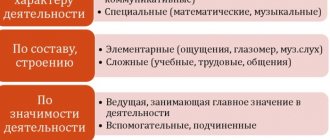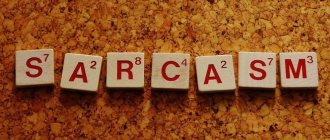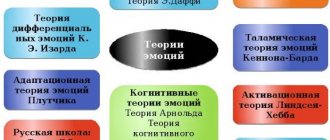Agglutination is the most important tool in psychology for assessing the state of an individual and his vision of the surrounding reality. The phenomenon of agglutination is very common in human nature and in the world in general. Sometimes observed in patients with schizophrenia or found in people suffering from speech disorders. The term agglutination describes the phenomenon that is the fusion of different elements (words, thoughts, images) into a single whole.
Agglutination in psychology is an imagination that is created by combining objects that exist in reality. This is a special type of connection, or rather merging, in which characteristics and traits that are absolutely uncombinable in objective reality are combined. A person’s imagination is essentially a dialogue that a person conducts with various parts of his “I”. Stimulants are various motives of vital necessity. Stimulation of the imagination itself is accomplished through human mental actions, which represent the formation of images.
Agglutination in psychology - examples are presented in fairy-tale images: centaurs (combining human features with the characteristics of a horse), sphinxes (features of a human face merge with the characteristics of a lion), mermaids (attaching a fish tail to the body of a beautiful woman), as well as other various mythological images. All these images appeared thanks to the rich human imagination. So, this very image of a centaur, most likely, was formed in conditions with poor visibility of a person jumping on a horse, so he seemed like some kind of fantastic animal. Also, the image of a man with wings appeared, apparently consciously, because it symbolizes the very idea of a person moving through the air, formed in such a sensual image.
The phenomenon of agglutination is a process that is related to psychology and is found in medicine and linguistics.
The process of agglutination in linguistics means the merging of different words into one, with a reduction in the morphological structure, while maintaining the original meaning. That is, agglutination in linguistics is a process in which different morphological elements of a language are combined into a whole, creating words.
The concept of agglutination in psychology
By this definition, psychologists understand a certain play of the individual’s imagination, as a result of which completely new images, postulates and ideas are born, uniting qualities and characteristics of various phenomena and objects that are not comparable in real terms. The word “agglutination” itself, translated from Latin, literally means gluing, sticking together.
Agglutination in psychology is a special type of connection or fusion in the imagination of unconnected features and characteristics of different objects.
Agglutination is classified as an analytical-synthetic process. The result of the work of the imagination (or the process of agglutination) is the emergence in a person’s head of a collective image of several figures, characters and types that are incompatible in primary perception.
Vivid examples of how the imagination works are such famous images created by people as a centaur or a hut with chicken legs. It is agglutination that helps writers, poets, artists and screenwriters realize their creative ideas.
The creation of a new holistic image is possible thanks to the specifics of the functioning of the human brain - analysis and synthesis. By analyzing data, a person breaks down incoming information into its component parts, and by synthesizing them, he gets the opportunity to combine it into new ideas and concepts.
However, it is worth understanding that this process of “putting together a mosaic” is not chaotic. The combination of various details into a single whole is facilitated by a certain idea, design or other motives, which can sometimes manifest themselves in the context of a person’s subconscious.
In this case, the starting point for these transformations will be a person’s personal experience. The possibilities of his imagination will depend on how bright and varied he is.
Sometimes agglutination may indicate the presence of certain serious mental illnesses (schizophrenia), as well as speech disorders. The neologisms (new words) that arise will not have much meaning and, most often, will be incomprehensible not only to the doctor, but also to the patient himself. However, it is the appearance of such neologisms that makes it possible to diagnose these diseases.
Causes of agglutination
Agglutination in psychology is a game of imagination, based on the previously acquired experience of an individual, as a result of which new images arise.
The reasons for the phenomenon are:
- features of human mental activity - it is human nature to analyze and synthesize information, which leads to its transformation and combination into unexpected forms in different individuals;
- existing experience – the acquired knowledge is not kept idle in people’s heads. The peculiarity of a thinking person, as mentioned above, is that he strives to use the accumulated experience, passing the information received through the prism of his own thinking;
- the desire to create something new - sometimes it happens that a person is fascinated by an idea, but for its concrete expression he needs to create something new, previously unknown, in his head;
- the dynamism of the development of the world - human consciousness knows that the world is not something immutable and static and that it can be changed by creating something new - discoveries, achievements and inventions, while improving one’s life.
Sometimes the causes of agglutination are mental illnesses and disorders in the development of speech, but these cases are extremely rare.
Bottom line
Imagination, or fantasy, is a thought process that occurs both under the guidance of a person and without his participation. Imagination is a creative process that involves creating something that the world has not yet seen or is not familiar with. Usually new ideas and images are not introduced into real life because they are not consistent with natural laws. However, if a person is able to realize his idea, adapting it to real conditions, then the new thought becomes an innovation.
All this allows a person to experiment and make the world diverse. All this allows a person to feel like God. However, not everything is so simple, because sometimes agglutination is a consequence of a mental disorder in the processes of thinking or perception of the surrounding world. In this case, we are already talking about treating a person in order to rid him of hallucinations that he considers real and significant in his life. Here you cannot do without the help of a specialist.
Signs
Agglutination in psychology is a person’s imagination, with the help of which, by analyzing and synthesizing information obtained experimentally, he manages to recreate new objects as images and ideas.
If we talk about agglutination as a normal mechanism of the imagination, during which new ideas are generated, then we can highlight the following distinctive features of this process:
- the brightness of incoming images;
- their novelty and originality;
- varying degrees of realism and truthfulness of emerging theses;
- sustainability;
- arbitrariness and controllability - a person can control his mental activity.
If we are talking about agglutination associated with mental disorders or speech disorders, then some signs may have their own characteristics. Thus, the images that come to the minds of mentally ill people can be no less stable, vivid and new than those of a healthy person.
However, they arise involuntarily in such people and the sick person is not able to control the occurrence of obsessive ideas and scenarios in his head.
What laboratory tests show
When examining sperm (spermogram), its full assessment is carried out: viscosity, volume, color, liquefaction rate, reaction, the number of “little ones”, their morphology and mobility are examined. In addition, they look to see if there is agglutination in the spermogram, blood, leukocytes, mucus or red blood cells.
Even if you have been found to have this pathology, this is not a death sentence and there is an opportunity to improve the situation.
To obtain accurate data, ejaculate is taken for research directly in the laboratory through self-masturbation.
The degree of agglutination is taken into account as follows:
- “+” – minimum of adherent groups of sperm: no more than 5 “tadpoles” in each;
- “++” – groups of 10-20 “livelings”;
- “+++” – groups of up to 5 pieces, and each of them contains several dozen “tadpoles”;
- “++++” – in the field of view under a microscope there is a large number of stuck together sperm.
With a high degree of sperm adhesion, we can talk about the immunological factor of infertility, chronic inflammation in the body and autoimmune processes. Sperm agglutination caused by the production of ACAT requires confirmation by a spermogram with a MAR test. Only after the cause has been established is treatment prescribed.
Degrees of agglutination
Agglutination is a mental process in which the imagination plays a dominant role. In psychology, there are several degrees or stages of agglutination that a person goes through at each stage of his development and formation.
| Involuntary | Occupies a time period in early childhood from 2 to 4 years. At this age, the development of the baby’s mental activity allows him to reproduce previously acquired knowledge and impressions, but the child is not yet able to create and combine various images. |
| free | It develops after 4 years and is accompanied by the transition of mental activity into the active phase, when the child can not only reproduce some kind of drawing on paper, but also come up with something of his own. During this period, play activity is indicative, in which the process of agglutination is revealed to the maximum. |
When the process of agglutination occurs involuntarily, then pictures and images in a person’s head arise unintentionally and are based on previously gained experience. The most striking example of the involuntary work of the brain and imagination is dreams.
With the voluntary process of agglutination, mental activity is not limited only to the reproduction of previously received impressions. As a result of conscious voluntary processing of information, dreams appear, creative imagination develops, and new ideas and images are born.
Does illness interfere with the ability to have children?
A small degree of agglutination may not have any effect on reproductive function. If a sufficient number of free sperm remains in the ejaculate, fertilization of the egg is possible.
Problems arise when agglutination is assessed as three or four pluses. Then the sperm stick together instead of moving towards the egg. Such gametes are not capable of fertilization. In this case, IVF may be performed.
During IVF, sperm are freed from antibodies in the laboratory and then implanted into an egg. Sometimes, for a married couple this is the only opportunity to conceive a child.
Examples of agglutination
In fact, the process of agglutination is extremely important, because it is the main engine of the progressive development of all mankind. The wheel, bicycle and steam locomotive arose in their time precisely as a result of intense human brain activity, and therefore it is wrong to think that agglutination helps only people of creative professions.
The most common, familiar and understandable examples of agglutination are unprecedented fairy-tale characters:
- Phoenix;
- mermaid;
- a hut on chicken legs;
- centaur.
All these characters appeared as a result of the merger of several components; they do not actually exist, but the idea turned out to be so successful that it was remembered and appreciated by many people.
Literary authors also often create their heroes based on a certain collective image. Thus, the great Russian writer, Leo Tolstoy, more than once admitted that the image of Natalya Rostova from the work “War and Peace” was actually invented by him, thanks to women who really existed close to him - his sister and wife.
In addition to writers, agglutination also plays a huge role for artists who create paintings. It is known that Leonardo da Vinci taught his students the techniques of gluing together several images.
Ways to create images of the imagination
It is wrong to believe that creative activity, imagination and the process of agglutination itself are built chaotically and chaotically. In fact, the transformation of reality into new images is subject to its own laws and occurs in accordance with certain techniques and methods.
As mentioned earlier, thanks to analysis and synthesis, new ideas can arise, and therefore the very process of mental division of information into its component parts and its subsequent connection is of an analytical-synthetic nature.
In psychology, the following methods and techniques for creating images in the imagination are distinguished:
- Hyperbolization is a deliberate increase or, on the contrary, understatement of an object or its parts. The easiest way to trace this is through the example of folklore, in which all heroes were endowed with mighty strength, strength and height, or, on the contrary, individual heroes had diminutive characteristics that did not prevent them from demonstrating extraordinary mental abilities (Tom Thumb). This technique is used not only in Slavic folk art, but can also be seen in fairy tales and stories of other nationalities (Cyclops with one eye, Buddha with several arms).
- Agglutination - as a method of imagination, involves the mental connection of various parts of objects or elements together. Using this method, images of a mermaid and a centaur were created.
- Accentalization – involves highlighting any part or individual detail in a newly created image. This technique of emphasis or sharpening is often used by caricaturists, emphasizing some shortcomings in the image, for example, a talkative person can be depicted with an enlarged tongue, a lazy official can be depicted as fat and with a large belly.
- Typing - or typification, on the contrary, involves the creation of collective images inherent in many people or phenomena. These could be jealous heroes (Othello) or, for example, dishonest lovers of power and money.
- Schematization is a process as a result of which similar motifs or features are identified in dissimilar objects, and on the basis of this, something new is created, for example, an ornament or pattern characteristic of a particular nationality.
Emphasis as a mechanism of imagination
The concept of “emphasis” is understood as the process of emphasizing certain specific features of an object. In this case, a change in the proportions of the object may occur. Accentuation, in other words, is called sharpening.
Examples of emphasis can be caricatures - a type of art that ridicules ideas, vices, phenomena, people using stereotypes, caricatures - a type of art similar to a caricature, but there is no purpose to ridicule, only an emphasis is placed on certain specific features.
The concept of emphasis includes the concepts of hyperbolization (exaggeration of the properties of an object) and litotes (decreasing the properties of an object).
How is the problem diagnosed?
Agglutination in psychology is a powerful mental practice of processing information, allowing you to divide it into separate parts and create completely new objects, both material and immaterial. Thanks to this process, humanity does not stand still, but is constantly evolving. However, sometimes this phenomenon can be associated with certain mental disorders.
Thus, during an exacerbation of schizophrenia, one of the most striking symptoms is agglutination. At the same time, the sick person loses the ability to distinguish between certain concepts, since due to disorders his brain perceives the new images that arise as true.
The same situation can also be observed with deviations in speech development, which, as a rule, are closely related to mental disorders. At the same time, such people come up with new words (neologisms), the meaning of which is unclear even to them.
Often, in people with schizophrenia, the normal perception of their own personality is disrupted due to agglutination. They may identify themselves so closely with other individuals or even phenomena that they become unable to distinguish between themselves and their imagination.
As a result, the events of the outside world are very closely intertwined with their lives, and they may claim that some phenomena are their expression (for example, it seems to them that the rain is their tears).
Diagnosing schizophrenia is a fairly long process, since to make this kind of diagnosis, specialists comprehensively study the patient’s life and symptoms:
- patient complaints are taken into account;
- a survey is conducted of people close to him who can characterize his behavior;
- attention is paid to the general state of health, existing chronic diseases, injuries;
- It is examined whether the patient has encountered:
- hallucinations;
- delusional obsessions;
- repetition (“echo”) of one’s own thoughts;
- the feeling that his thoughts are open to everyone.
At a minimum, the specialist observes the patient for a month before making a diagnosis. In addition to behavioral and cognitive deviations, attention is drawn to the presence of neologisms in speech, which may also indicate schizophrenia.
Other methods
Universalization.
Universalization is the process of optimizing work by expanding functions. The purpose of this method is to save money. Universalization can be achieved by combining systems that have a certain common part. Due to the fact that there is a certain common part, both systems as a whole become more economical than each of them separately.
Synectics.
The purpose of this melody is to find new solutions to creative problems. Synectics is an advanced method of brainstorming. Unlike the brainstorming method, criticism is allowed in this technique. It is also allowed to change statements and ideas. According to the rules of the methodology, the same group of people should search for a solution.
Sabotage method.
The purpose of the sabotage method is to identify and predict undesirable situations in a technical system. In order to find a weak point, it is necessary to create an extreme situation. During an extreme situation, it becomes clear which areas are weak, and then the problem of strengthening these areas is solved.
Systems method.
The goal of the systems method is to create a new object or system. In addition to the system, this method also includes subsystems and supersystems. A subsystem is the individual parts of an object, and a supersystem is something large of which the object is a part. The system, supersystem and subsystem can also be considered from a time position, that is, what happened in the past with these elements, what is happening now and what will happen in the future. This method allows you to generate a large number of ideas.
Association method.
The purpose of the association method is to generalize new ideas. To do this, you should choose two classes that will essentially be opposite. Each of these groups will have its own specific features and characteristics. It is necessary that the elements of each group begin to exchange their specific characteristics. It should be noted that in order to get more incredible ideas, it is advisable to choose items that are as different from each other as possible.
Method of focal objects.
The goal of the focal object method is to search for ideas in unexpected directions. The focal object is the object that is in your attention. The essence of the method is to transfer the properties of random objects to the focal object. This method assumes that the user must have as much imagination as possible. But thanks to this method, it is possible to generate a large number of extraordinary solutions in a short time.
Treatment
If we are talking about agglutination, as a result of which new interesting, non-destructive ideas are born and useful ideas are realized, then this type of mental activity does not require any treatment.
On the contrary, this may indicate the harmonious development of the individual and her ability to comprehensively apply her experience and develop her imagination.
In the case when a person has speech disorders associated with mental disorders or is diagnosed with schizophrenia, then such a person should be provided with comprehensive assistance from specialists, otherwise the process of agglutination in such people can lead to sad consequences both for themselves and for their environment.
Until now, the concept of treating this type of deviation causes a lot of controversy among specialists, since there are no uniform approaches to the treatment of this condition. Most experts believe that schizophrenia can be treated on an outpatient basis, resorting to hospitalization only in severe forms. Treatment methods include drug therapy, as well as psychocorrective work with the patient.
Medication
The symptoms that accompany the process of agglutination in speech disorders and schizophrenia are, for the most part, amenable to medication adjustment.
American psychiatrists generally recommend using atypical neuroleptics for the treatment of such patients, which act specifically on the negative signs of the disease. At the same time, they note the importance of an individual approach and optimization of treatment regimens for each patient.
To treat such patients, medications such as:
- Clozapine;
- Risperidone;
- Olanzaline;
- Amisulpride.
Patients should continue to take these medications after the acute attack has stopped, in order to maintain remission and minimize the risks of exacerbation of the disease.
When using these medications, 40-50% of patients respond positively to therapy, 30-40% respond slightly worse, and only 20% of patients do not have the desired effect. Also, these medications reduce the negative phenomena characteristic of this disorder, reducing the tendency and craving in such patients for suicide, drug addiction, and alcoholism.
Psychotherapy
If agglutination is a symptom of a disorder, psychotherapy is often used to correct the condition, which is carried out in combination with drug therapy. Only medication relief of the symptoms of the disease will not be able to fully return the patient to full social and professional activities.
To work with such patients use:
- cognitive behavioral therapy – this technique has a solid evidence base and can reduce the number of relapses of the disease in patients. Its essence lies in working through the patient’s false destructive attitudes and reconfiguring his mental activity in the right direction;
- family therapy - when the patient interacts with the psychiatrist not alone, but together with his family. The specialist’s task is to identify problematic issues, resolve them and establish a normal healthy microclimate in the family, which will reduce the risk of exacerbation of the disease in the patient.
These techniques help patients better understand their condition and reduce episodes of delirium and hallucinations. The disadvantage of these approaches is their high cost, since such classes are conducted on an individual basis and are not cheap.
Diagnostics
Visually, aggregation and agglutination do not appear in the spermogram. The adhesion of spermatozoa does not change the organoleptic properties of seminal fluid. Only with a severe form of the inflammatory process and extensive gluing of gametes can one notice the presence of lumps in the sperm.
To diagnose the pathology, an extended spermogram with a MAR test is performed. The study allows us to identify antisperm antibodies, which become the main cause of germ cell adhesion. When diagnosing sperm, the classification of the pathological process is used:
- (+) – one plus indicates that the seminal fluid sample contains less than ten glued cells;
- (++) – reports that the number of adhered gametes is from 10 to 50;
- (+++) – indicates that more than 50 cells with agglutination were detected;
- (++++) – assigned to sperm in which all sperm are glued together.
Forecast
In approximately every 3rd case, over time, all unpleasant symptoms are relieved and the patient feels like a full-fledged member of society.
Another significant proportion of such patients demonstrate moderate remission, with an almost complete absence of manifestations of the disease (including unhealthy agglutination). Success in treatment depends on the timeliness of identifying the problem and the complexity of the approach to treatment - a combination of psychocorrection with drug treatment.
If there is a favorable environment in the family and all the doctor’s recommendations are followed, it is possible to avoid acute manifestations of the disease (delusions, hallucinations), as well as to prevent the patient’s social degradation, which is expressed in an increased tendency in such patients to:
- taking drugs;
- drinking alcohol;
- suicide.
Agglutination is a unique form of thought process that allows a person to discover new things by processing previously received information.
In psychology, agglutination can be considered as a useful tool that allows a mentally healthy person to develop, as well as a symptom of serious mental disorders. As a rule, these deviations do not occur often, so agglutination largely helps people improve their experience and find new answers when solving various problems.
Decoding test results using a simple method
After the specified time, clearing is observed in the serum drops. In some you can see that agglutination of red blood cells has occurred (small flakes), in others it is absent.
The following options exist:
- no reaction in all serum samples - group 1;
- coagulation occurred everywhere except for sample 2 – group 2;
- no reaction only in the 3rd sample – group 3;
- agglutination occurred everywhere – group 4.
Thus, the main thing is to distribute the serums correctly. Then deciphering the result will not be difficult. If blood agglutination is weak, it is recommended to repeat the test. In the case of small flakes, they are examined under a microscope.











